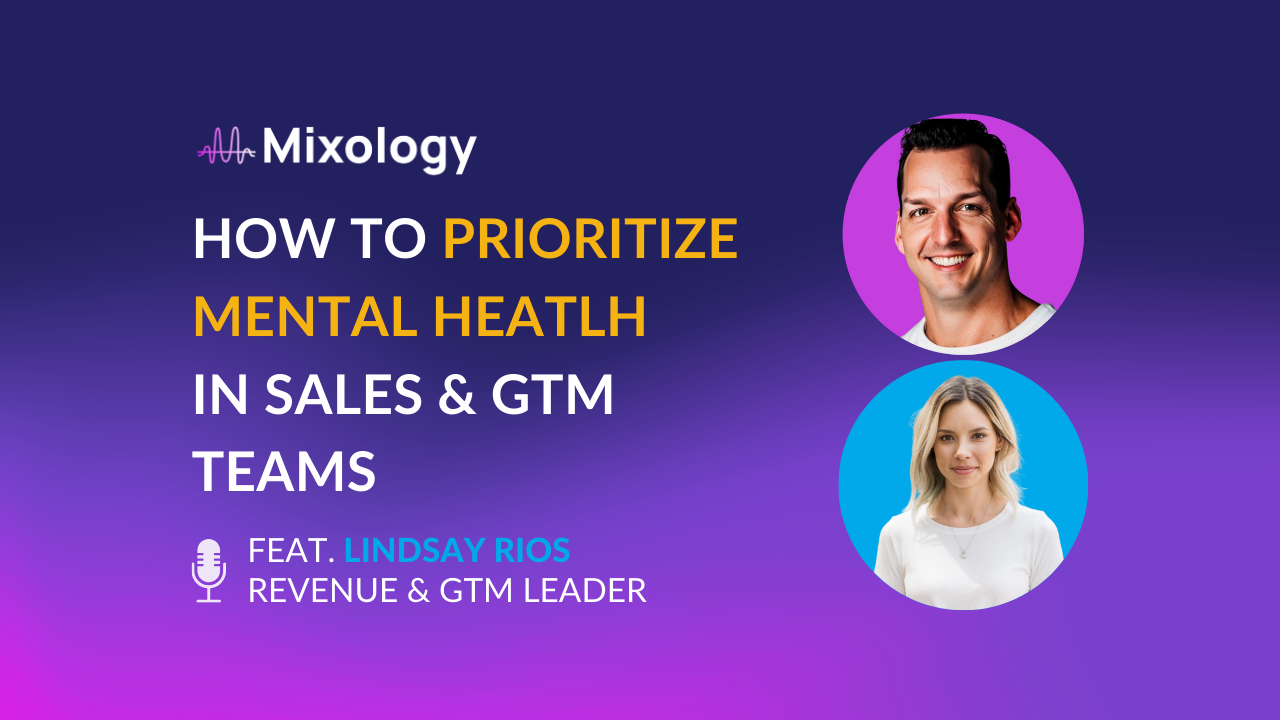Sales can be a wild ride. One minute, you’re celebrating a closed deal; the next, you’re ghosted by a dream prospect.
It’s emotional, it’s high stakes, and, let’s be honest, it’s exhausting. Yet, despite the pressures, mental health in sales remains a topic that often goes unspoken.
Why?
Heath Barnett, VP of Revenue at Mixmax, recently sat down with Lindsay Rios, a seasoned revenue and GTM leader, to talk about why this needs to change—and how sales leaders can create environments where mental health is a priority.
Why mental health in sales matters
“A horrible job or a horrible boss can ruin your life,” Lindsay shared early in the conversation. The average person spends 90,000 hours of their life at work, so finding a job you love—or at least one that doesn’t drain the life out of you—is crucial.
Lindsay’s own experiences in industries with poor work-life balance highlighted the importance of creating spaces where people can thrive both professionally and personally.
“You deserve to be happy,” she emphasized. “It’s possible, but it takes intentional choices.” For sales professionals, this might mean advocating for boundaries, seeking out supportive cultures, or even just learning the power of saying “no.”
Sales culture: Breaking the hustle mentality
Sales has long celebrated hustle culture. We’ve all seen the cliché slogans—“Coffee is for closers” and “Always be closing.” But Lindsay believes it’s time to trade bravado for balance.
“When you’re a happy and healthy human, you do better in your job,” Lindsay said. She recalled a pivotal moment when a CEO shared his personal struggles with anxiety and announced free therapy for employees through a service called Spill. “It starts from the top,” she said. “When leadership is transparent about mental health, it sets the tone for the entire organization.”
Practical tips for leaders to prioritize mental health
Lindsay and Heath offered several actionable strategies for fostering a healthier work environment:
- Model boundaries: Lindsay implemented “Me Days,” a monthly day off dedicated to self-care. By openly taking these days, she encouraged her team to prioritize their own needs without guilt.
- Proactively encourage time off: Lindsay is known for telling her team to “lovingly, go away.” Whether it’s through PTO reminders or tools that track unused vacation days, leaders should ensure employees are actually taking breaks.
- Create a plan for time off: At one organization, Lindsay introduced Notion pages where team members documented pipeline updates and tasks before taking time off. This made it easier for colleagues to cover and for employees to return without feeling overwhelmed.
- Build personalized growth plans: Heath’s approach includes asking reps to create three goals: one related to their role, one for personal development, and one purely personal. “When people feel cared for as individuals, productivity becomes a byproduct,” he said.
- Rethink compensation structures: Lindsay highlighted the importance of realistic ramp periods and quota relief for extended time off. “Your comp plan speaks volumes about what you care about most,” she noted.
Recognizing burnout before it’s too late
Burnout doesn’t always announce itself with fanfare. Lindsay and Heath discussed red flags to watch for, including:
- Employees failing to follow through on tasks despite detailed plans.
- Sudden drops in performance or engagement.
- Signs of emotional withdrawal or frustration.
“If someone’s not doing well in their job, my first thought isn’t that they’re not capable,” Lindsay said. “It’s, ‘What’s going on in their life?’” She stressed the importance of empathy and checking in with team members regularly.
| Related post: How to Nail LinkedIn Social Selling and Reach More Buyers with Mandy McEwen |
How mental health in sales drives performance
Skeptics might wonder how focusing on mental health impacts the bottom line. Lindsay’s challenge to them? “Try it. See what happens.”
She believes that when people feel supported and valued, they’re more engaged, productive, and loyal.
And for leaders worried about dropping the ball, Heath reminded listeners of a simple truth: “Saying no to certain things allows you to make a bigger impact on what truly matters.”
Final takeaway: Building a blueprint for balance
For Lindsay, prioritizing mental health starts with choosing organizations that align with your values. From there, it’s about proactive planning, open conversations, and setting an example for others to follow.
“You can’t take care of other people if you’re not taking care of yourself,” she said. “Get to know your team—what motivates them, what they care about—and build a culture that supports them as people, not just as sales reps.”
Sales is tough, but it doesn’t have to come at the expense of well-being. By embracing the conversation around mental health in sales, leaders can create environments where teams don’t just survive but thrive.



.png?width=450&height=250&name=Episode%20Graphic%20(1).png)
